DVD Review: “All Monsters Attack”
Released By: Classic Media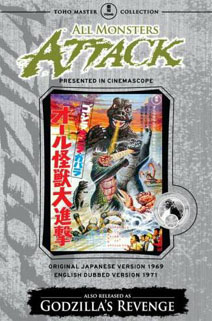
Release Date: April 29, 2008
Number of Discs: 1
Approximate Running Time: 138 Minutes
Special Features: Audio Commentary, Image Galleries, Ishiro Honda Biography
Suggested Price: $16.93
The Source:
In 1968, the waning Godzilla film series was revitalized by the strongest installment of its original run, Destroy All Monsters (All Out Charge of the Monsters in Japan). The immediate follow up the next year,All Monsters Attack, not only plunged the series in the opposite direction but nearly brought it to an end. A unique film by Godzilla standards and an ill fit with the other installments, All Monsters Attack is the story of a young boy’s fantasies rather than a giant monster slug-fest. For once, the Godzilla storyline was completely secondary to (or even a product of) the human one. Ichiro is the original latch-key child, nearly abandoned by his parents who are both working long hours in a struggle to make ends meet. He is essentially 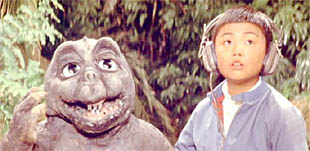 raised by an eccentric neighbor, a toy designer, who is distracted by his work as well. Left to his own devices, Ichiro wanders the streets, plunders crumbling abandoned buildings, and runs into repeated trouble with the local bully and his gang. With no adult support system to fall back on, he retreats into a world of fantasies where Godzilla, his son (named Minya here), and other monsters help him deal with his problems. When Ichiro is kidnapped by bank robbers after accidentally discovering their hideout in one of the buildings he frequents, he must use the lessons taught to him by his monster pals to escape.
raised by an eccentric neighbor, a toy designer, who is distracted by his work as well. Left to his own devices, Ichiro wanders the streets, plunders crumbling abandoned buildings, and runs into repeated trouble with the local bully and his gang. With no adult support system to fall back on, he retreats into a world of fantasies where Godzilla, his son (named Minya here), and other monsters help him deal with his problems. When Ichiro is kidnapped by bank robbers after accidentally discovering their hideout in one of the buildings he frequents, he must use the lessons taught to him by his monster pals to escape.
The Fanboy Factor:
After the success of Destroy All Monsters in the US, American distributors were eager for 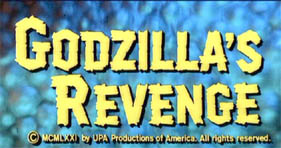 another Godzilla picture. When this one turned up on their doorsteps though, they were absolutely baffled by how to market it. After scratching their heads for two years, they finally retitled the film Godzilla’s Revenge, gave it a misleading ad campaign that sold it as a horror movie, and dumped it on a double bill with the completely unrelated British film Island of the Burning Damned. Those few poor filmgoers tricked into seeing this film in theaters must have really wondered what they had gotten themselves into.
another Godzilla picture. When this one turned up on their doorsteps though, they were absolutely baffled by how to market it. After scratching their heads for two years, they finally retitled the film Godzilla’s Revenge, gave it a misleading ad campaign that sold it as a horror movie, and dumped it on a double bill with the completely unrelated British film Island of the Burning Damned. Those few poor filmgoers tricked into seeing this film in theaters must have really wondered what they had gotten themselves into.
Referred to by many fans as “Godzilla vs. Hostile Stock Footage”, Revenge features only a handful of new scenes involving the monsters. The majority of the new footage centers on Minya, who befriends young Ichiro and serves as his translator and liaison for the other monsters. To accomplish this, the junior Godzilla is given the ability to shrink down to human size and speak English (or Japanese depending on which version you are watching)! Minya, with his ventriloquist dummy features and dopey voice in the US cut, comes off as having the monster equivalent of Downs Syndrome. If you never see another moment of any Japanese version of a Godzilla film, at least watch a few of the Minya scenes from this film to see how different his personality was intended to be. Thankfully, this was Minya’s final appearance in the original series and no one missed him.
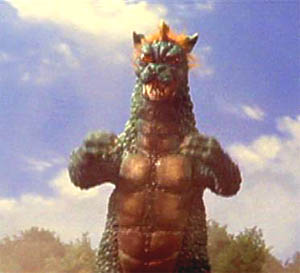 Making his debut and only appearance to date is the villainous Gabara, a sort of reptilian, cat-faced monster that can shoot lightning charges from his hands. Far from the most menacing foe Godzilla has ever faced, Gabara isn’t even on par with many of the Ultraman monsters from television. The remainder of the running time is filled up with stock footage, mainly from Godzilla vs. the Sea Monster and Son of Godzilla. While this was a cost cutting cheat by the producers, it did give American audiences their only chance to see these scenes on the big screen since both of the previous films had been sold directly to television in theUS.
Making his debut and only appearance to date is the villainous Gabara, a sort of reptilian, cat-faced monster that can shoot lightning charges from his hands. Far from the most menacing foe Godzilla has ever faced, Gabara isn’t even on par with many of the Ultraman monsters from television. The remainder of the running time is filled up with stock footage, mainly from Godzilla vs. the Sea Monster and Son of Godzilla. While this was a cost cutting cheat by the producers, it did give American audiences their only chance to see these scenes on the big screen since both of the previous films had been sold directly to television in theUS.
The Product: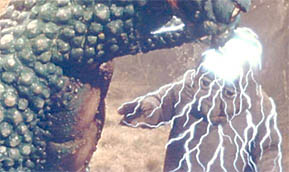
Once again, Classic Media has given Godzilla fans the original Japanese version of this film and the more familiar US one. They have also provided some extras including a feature length commentary by Godzilla expert Richard Pusateri, production stills, and a brief documentary on legendary director Ishiro Honda. What they have also done, once again, is completely ignore the US theatrical release of the film. This has been a major complaint throughout their DVD series but it is particularly regrettable here where the American promotional material is so amusingly misleading. The transfer on the US version of the film also looks suspiciously like it might have been sourced from VHS tape. The colors tend toward overly bright and there is noticeable hiss on the soundtrack that hasn’t been present in any of their other Godzilla titles I have reviewed.
The Bottom Line:
As if the film itself wasn’t reason enough, there are enough minor irritants here that anyone outside of Godzilla completists should avoid this DVD or they may be seeking their own revenge!
